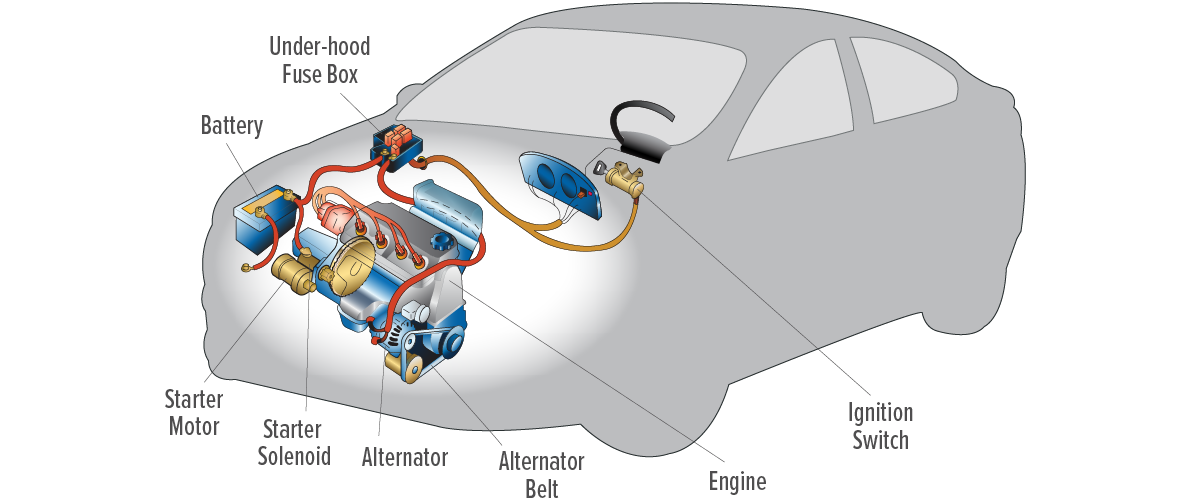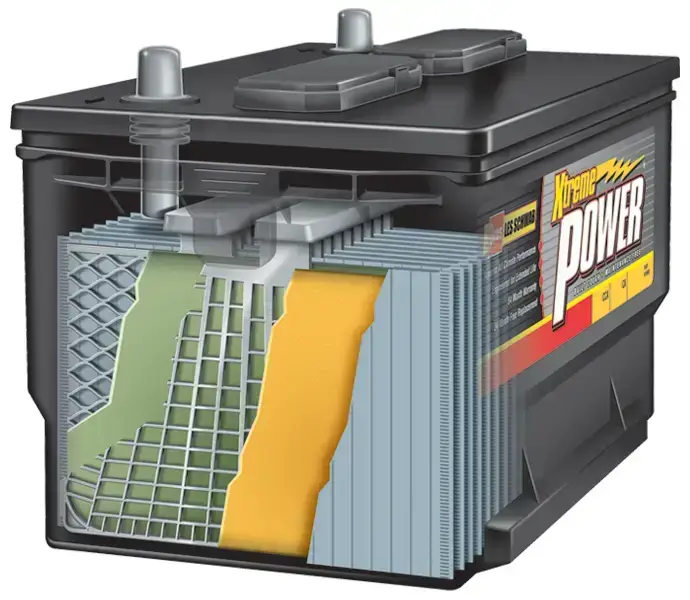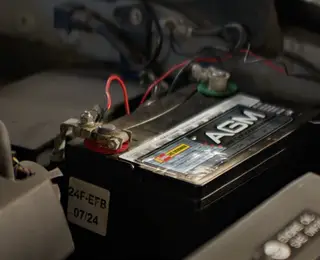How Your Auto Battery Works (and Seasonal Tips to Extend Its Life)
Today’s 12-volt car batteries might seem complicated, but when you have some basic information they’re easy to understand. The Les Schwab team of professionals has put together a quick guide to understanding how car batteries work, from the alternator to cold cranking amps to different types of car batteries.
In This Article
- A word about electric vehicles
- How a battery starts your car
- How the battery provides power
- What cold cranking amps are
- How the battery recharges
- Why car batteries die
- Different types of auto batteries
- How Weather Affects Your Battery
Electric Vehicles and 12-Volt Batteries
Every vehicle has a 12-volt battery. This includes electric vehicles (EVs). In an electric vehicle, the 12-volt battery powers the accessories and starts the vehicle’s system, including the onboard computer, which energizes the main battery. Throughout most of this guide, the information is about the battery in a gas-powered vehicle, unless otherwise indicated.
How a Car Battery Starts a Car
The first purpose of an auto battery is to provide power to your vehicle, whether you drive a gas-powered truck or an EV. In a gas-powered vehicle, it also acts as a surge protector for the car’s computer and provides power for short-term use of things like lights, stereo, navigation, or wipers when the engine is off.
The car battery in a gas-powered vehicle is part of the starting system. This system consists of the ignition switch (either the starter button you press or where you insert your key), and the switch that controls the starter relay (also called a solenoid). When you turn the ignition, it sends a small electrical current to the starter relay. This causes a pair of contacts to close. When those contacts close, the battery sends voltage to the starter motor, which turns some gears to start the car.

How the Battery Provides Power
The two main types of auto batteries are flooded and AGM batteries. Both use lead-acid technology. A typical lead-acid car battery contains plates of lead alternating with plates made up of other materials, all immersed in an electrolyte solution of about one-third sulfuric acid and two-thirds water.
Turning the ignition in your car triggers the acid in the liquid electrolyte solution to react with the active material on the plates (active material refers to any substance in the battery that reacts with the solution to discharge or recharge the battery). This generates an electrical current. In a gas-powered vehicle, the current travels through the starting system in a chain of reactions that cues the engine to start.

What Are Cold Cranking Amps?
Cold-cranking amps (CCA) refers to the amount of power a battery can supply for 30 seconds, even at low temperatures. Larger engines require more power to start, as does starting the car for the first time on a cold day.
A high CCA rating is important for standard auto batteries in areas with subzero temperatures, since deeply discharged wet cell batteries can freeze solid.
How a Car Battery Recharges
The alternator, found in gas-powered vehicles, is responsible for recharging your car battery as you drive. This part also supplies power for your car’s electronics when you're underway. It is driven by the alternator belt from the engine. As the belt goes around, it generates electrical current to run your vehicle's electronics. It also sends some current back to the battery to recharge it.
A voltage regulator controls this flow of electricity to keep it even and deliver the right amount of charge to run the AC or heater. It also protects the battery from damage caused by overcharging.
Why Does My Battery Die?
Over the life of a battery, discharge-recharge reactions happen thousands of times. Each cycle wears out the plates a bit, and over time the lead deteriorates. As your car battery loses capacity, cold cranking amps decrease.
Deep discharging in a gas-powered vehicle, which happens when you use the battery to run the stereo, lights or other electrical systems in your car when the engine is off, is responsible for a good portion of battery failures.
Discharging most of your battery's capacity and then recharging it through driving can cause the sulfur in the electrolyte solution to stick to the lead and damage the plates in the battery. Yes, jump-starting your vehicle when the battery dies can get your car running again. But it will cause some damage to the battery.
What Are the Different Types of Auto Batteries?
The two most common auto batteries for sale today are standard wet cell batteries and absorbed glass mat (AGM) batteries. Both use lead-acid technology. The differences are in the needs of the car.
Standard Wet Cell Batteries
These are also called flooded, conventional or SLI (starting, lights, ignition) batteries. Some standard batteries have vents that allow for airing out corrosive gases, steam, and condensation (these may be called vented batteries). They have removable caps for adding fluid. Other wet cell batteries are closed systems, with no removable caps.
These batteries require occasional simple maintenance, including removing corrosion from the terminals and topping off the fluid with distilled water if the battery has removable caps. The battery should be visually checked every year. Additionally, the battery should be checked before road trips and sometime in the fall (after summer temperatures have subsided).
Absorbed Glass Mat (AGM) Batteries
These are a type of VRLA battery, which stands for valve-regulated lead-acid. They’re sometimes called regulated valve, dry cell, non-spillable or sealed batteries that do not have removable caps. These sealed batteries do have pressure-activated relief valves that open only if the battery overheats during recharging.
Wet cell batteries and AGM batteries are not interchangeable. Your car requires one or the other. Most EVs use a deep-cycle AGM battery. In addition, some newer gas-powered cars and EVs use AGM batteries. These batteries will continue to deliver power to a car’s computer and electronics even when the engine isn’t running.
AGM batteries hold a charge longer than standard wet cell batteries. They can tolerate periods of disuse and repeated deep discharging and recharging cycles better than flooded batteries. They have a short recharge period but they can be easily damaged by overcharging. They also perform well in harsh climates with extreme heat or cold. As with any 12-volt battery, they should be checked before road trips and after plenty of summertime use.
How Weather Affects Your Battery
Both hot and cold weather can affect your car’s 12-volt battery. Let’s take a look at both extremes.
Summer Heat Can Cause Damage
It might seem like cold weather kills the most batteries, but it’s really hot, summertime temperatures that do the most damage. It’s not until winter, when the cold requires that a battery work harder, that you experience the loss of battery power.
When temperatures soar, the water in your battery can evaporate. This is rather common and can cause permanent damage over time. Heat can also cause battery swelling and corrosion at the posts.
Cold Weather Makes Starting Harder
The 12-volt battery in your gas-powered and/or EV works hard. After some hot summer weather, that battery can really struggle when temperatures drop below freezing. Those colder temperatures can cause a slowing of the electrochemical reaction. This means your car battery might struggle to start your vehicle or not at all.
Additionally, gas-powered vehicles are a complex network of fluids, belts, hoses, and controlled explosions. As the fluids in that vehicle get colder, they become thicker, requiring more power to move the fluid inside the motor and start the vehicle.
How to Care for Your Battery Year-Round
To get the most life possible out of your 12-volt battery, try these tips.
- Park in a garage or under a cover. Keeping your vehicle out of direct sunlight, snow, and ice can help your battery last longer.
- Test your battery. Once a year, stop by Les Schwab for a free battery check. If yours is more than five years old, get it checked more often and replaced when needed.
- Check the terminals. Clean corrosion off the battery and tighten the clamps to ensure a good connection. Please note: Batteries contain sulfuric acid and can cause injury. Wear appropriate safety equipment before working on your car battery. This includes protective glasses and gloves. Additionally, avoid wearing baggy clothing or metallic jewelry while inspecting or cleaning your battery.
- Use a trickle charger or plug in your EV. In the cold winter months, a trickle charger can keep your battery charged. Plugging in your EV can help your 12-volt battery from draining.
- Go for a drive. If you own a gas-powered vehicle, start it up and go for a short drive once a week. This can help keep the battery charged.
When to Get Your Battery Tested
To ensure you aren’t left stranded by a dead battery in the winter, stop by Les Schwab anytime in the fall for a free battery check. Our professionals will check your battery for damage caused by the summer heat and share your options, including free overnight recharging.
Schedule a Battery Check
Not sure how your battery’s holding up? Visit your local Les Schwab for a free battery check and peace of mind before the season changes.
